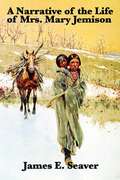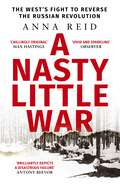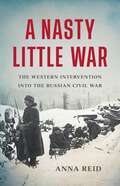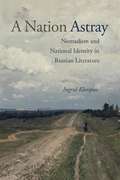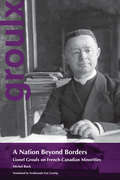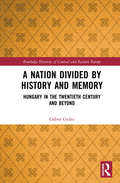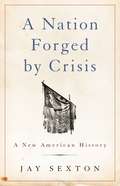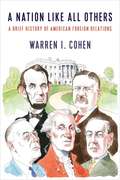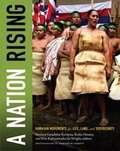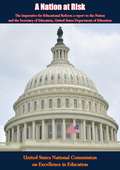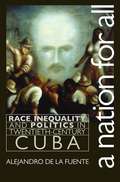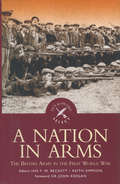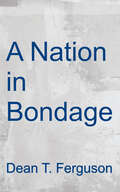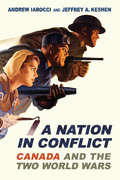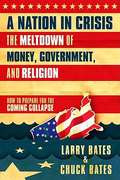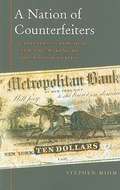- Table View
- List View
A Narrative of the Life of Mrs. Mary Jemison
by James E. SeaverMary Jemison was one of the most famous white captives who, after being captured by Indians, chose to stay and live among her captors. In the midst of the Seven Years War(1758), at about age fifteen, Jemison was taken from her western Pennsylvania home by a Shawnee and French raiding party. Her family was killed, but Mary was traded to two Seneca sisters who adopted her to replace a slain brother. She lived to survive two Indian husbands, the births of eight children, the American Revolution, the War of 1812, and the canal era in upstate New York. In 1833 she died at about age ninety.
A Nasty Little War: The West's Fight to Reverse the Russian Revolution
by Anna ReidFrom the bestselling author of Borderland: A Journey Through the History of UkraineThe astonishing untold history of the Western invasion of Soviet Russia - and the tragedy it created.In the closing months of WW1, with the world exhausted and depleted by a long a brutal war, fifteen nations cobbled together an army of nearly 200,000 men and embarked on one of the most extraordinary and ambitious military ventures of the twentieth century. The Intervention in Russia's civil war was spearheaded by Britain, her colonial forces and allies. It was designed to stop the Bolsheviks in their tracks, reinstate conservative regimes in the Russian Empire and ensure that Germany did not fill the power vacuum which the Russian Revolution had created. Eighteen months later - after a long and bloody conflict between the Reds and the Whites, the execution of the former tsar and his family, and brutal famine - the British, American and French forces marched out again, surrendering to the unstoppable force of Soviet power. They sent thousands of White Russians into exile, and left death, starvation, destruction and mass pogroms in their wake. Weaving the story together through the diaries, letters, and news reports of many of the participants this is a war of wildly contrasting fronts. A war of private armies and terrible communication, with participants freezing in bunkhouses or gorging on caviar at balls, riding into towns on steam trains or raiding naval bases in speed boats, inventing currencies, fishing for salmon and leading long straggling lines of typhus-infected refugees to safety, as well as bloody fighting.Few have acknowledged the Intervention since. When the smoke had cleared, Soviet propagandists had a field day with it; mythologizing the arrogance and incompetence of the British alongside their fat and be-medalled White allies. For the two million White Russians who emigrated following the Revolution it was the great betrayal. In Western versions, it was easier to pretend the catastrophe had never occurred. A Nasty Little War sets history straight, peopling the battlefield with unforgettable character as it brings this tragic failure to life.(p)2023 Hodder & Stoughton Limited
A Nasty Little War: The West's Fight to Reverse the Russian Revolution
by Anna Reid'Chillingly original' Max Hastings'Brilliantly depicts a disastrous failure' Antony Beevor'Witty and elegant . . . Excellent background to today's events' Anne Applebaum'Britain's most forgotten war, brilliantly remembered' Simon Jenkins'Vivid and remarkably timely' Martin SixsmithFrom the bestselling author of Borderland: A Journey Through the History of UkraineThe extraordinary story of the West's intervention into the Russian Civil War In the closing months of the First World War, Britain, America, France and Japan sent 180,000 soldiers to revolutionary Russia, in a doomed attempt to unseat the Bolsheviks. Entangled in what they termed a 'comic opera' conflict, they crisscrossed the shattered empire in sleds, trains and paddlesteamers, bivouacked in log cabins and felt yurts, torpedoed warships from speedboats, improvised the world's first air-dropped chemical weapons, and organised several coups and at least one assassination. Cheered on by Churchill, they also turned a blind eye to their Russian allies' many atrocities.Two years later, as the Red Army swept the board, the West evacuated, leaving Russia more blood-stained and suspicious than ever. A Nasty Little War brings this forgotten misadventure vividly to life.
A Nasty Little War: The Western Intervention into the Russian Civil War
by Anna ReidThe first comprehensive history of the failed Allied Intervention in the Russian Civil War, a decisive turning point in the relationship between Russia and the West Overlapping with and overshadowed by the First World War, the Allied Intervention in the Russian Civil War was one of the most ambitious military ventures of the twentieth century. Launched in the summer of 1918, it drew in 180,000 troops from fifteen different countries in theaters ranging from the Caspian Sea to the Arctic, and from Poland to the Pacific. Though little remembered today, its consequences stoked global political turmoil for decades to come. In A Nasty Little War, top Russia historian Anna Reid offers a sweeping and deeply researched account of the conflict. Initially launched to prevent Germany from exploiting the power vacuum in Eastern Europe left by the Russian Revolution, the Intervention morphed into a bid to destroy the Bolsheviks on the battlefield. But Allied armaments, supplies, and loans could not prevent Russia&’s anti-Bolshevik armies from collapsing, and the Allies were forced to retreat in defeat. The humiliation sapped British imperial swagger, chastened American idealism, and stoked militarism and nationalism in France and Germany. Combining immersive storytelling with deep research, A Nasty Little War reveals how the Allied Intervention reshaped the West&’s relations with Russia, and set a pattern for other interventions to come.
A Nation Astray: Nomadism and National Identity in Russian Literature (NIU Series in Slavic, East European, and Eurasian Studies)
by Ingrid KleespiesThe metaphor of the nomad may at first seem surprising for Russia given its history of serfdom, travel restrictions, and strict social hierarchy. But as the imperial center struggled to tame a vast territory with ever-expanding borders, ideas of mobility, motion, travel, wandering, and homelessness came to constitute important elements in the discourse about national identity. For Russians of the nineteenth century national identity was anything but stable. This rootlessness is at the core of A Nation Astray. Here, Ingrid Anne Kleespies traces the image of the nomad and its relationship to Russian national identity through the debates and discussion of literary works by seminal writers like Karamzin, Pushkin, Chaadaev, Goncharov, and Dostoevsky. Appealing to students of Russian Romanticism, nationhood, and identity, as well as general readers interested in exile and displacement as elements of the human condition, this interdisciplinary work illuminates the historical and philosophical underpinnings of a basic aspect of Russian self-determination: the nomadic constitution of the Russian nation.
A Nation Beyond Borders: Lionel Groulx on French-Canadian Minorities (Biographies et mémoires)
by Michel BockThis book, first published as Quand la nation débordait les frontières (Hurtubise HMH, 2004), is considered the most comprehensive analysis of Lionel Groulx's work and vision as an intellectual leader of a nationalist school that extended well beyond the borders of Québec. Recipient of the 2005 Governor General's Literary Award in non-fiction, the original French edition also won the Michel-Brunet Award (Institut d'histoire de l'Amérique française), the Prix Champlain (Conseil de la vie française en Amérique), and a medal awarded by the Québec National Assembly. It was also shortlisted for the Jean-Charles-Falardeau Award (Fédération canadienne des sciences humaines du Canada) and the City of Ottawa Book Award. For over five decades, historians and intellectuals have defined the nationalist discourse primarily in territorial terms. In this regard, Groulx has been portrayed—more often than not—as the architect of Québécois nationalism. Translated by Ferdinanda Van Gennip, A Nation Beyond Borders will continue to spark debate on Groulx's description of the parameters of the French-Canadian nation. Highlighting the often neglected role of French-Canadian minorities in his thought, this book presents the Canon as an uncompromising advocate of solidarity between all French-Canadian communities.
A Nation Divided by History and Memory: Hungary in the Twentieth Century and Beyond (Routledge Histories of Central and Eastern Europe)
by Gábor GyániDuring the last few decades there has been a growing recognition of the great role that remembering and collective memory play in forming the historical awareness. In addition, the dominant national form of history writing also met some challenges on the side of a transnational approach to the past. In A Nation Divided by History and Memory, a prominent Hungarian historian sheds light on how Hungary’s historical image has become split as a consequence of the differences between the historian’s conceptualisation of national history and its diverse representations in personal and collective memory. The book focuses on the shocking experiences and the intense memorial reactions generated by a few key historical events and the way in which they have been interpreted by the historical scholarship. The argument of A Nation Divided by History and Memory is placed into the context of an international historical discourse. This pioneering work is essential and enlightening reading for all historians, many sociologists, political scientists, social psychologists and university students.
A Nation Dividing 1800-1860
by Mcdougal LittellThis volume includes original stories, brief biographies, retellings of classic literature, primary source documents, and literary connections focusing on key people and events in history during the time period of A Nation Dividing, 1800-1860.
A Nation Forged by Crisis: A New American History
by Jay SextonA concise new history of the United States revealing that crises--not unlike those of the present day--have determined our nation's course from the startIn A Nation Forged by Crisis, historian Jay Sexton contends that our national narrative is not one of halting yet inevitable progress, but of repeated disruptions brought about by shifts in the international system. Sexton shows that the American Revolution was a consequence of the increasing integration of the British and American economies; that a necessary precondition for the Civil War was the absence, for the first time in decades, of foreign threats; and that we cannot understand the New Deal without examining the role of European immigrants and their offspring in transforming the Democratic Party. A necessary corrective to conventional narratives of American history, A Nation Forged by Crisis argues that we can only prepare for our unpredictable future by first acknowledging the contingencies of our collective past.
A Nation Like All Others: A Brief History of American Foreign Relations
by Warren I. CohenBelief in the United States as a force for good in the world runs deep. Yet an honest consideration reveals a history marred by great crimes and ordinary errors, alongside many achievements and triumphs. In this comprehensive account of American foreign relations from the nation’s founding through the present day, the diplomatic historian Warren I. Cohen calls attention to the uses—and abuses—of U.S. international leadership and the noble as well as the exploitative ends that American power has wrought.In A Nation Like All Others, Cohen offers a brisk, argumentative history that confronts the concept of American exceptionalism and decries the lack of moral imagination in American foreign policy. He begins with the foreign policy of colonial and postrevolutionary America, exploring interactions with European powers and Native Americans and the implications of slavery and westward expansion. He then traces the rise of American empire; the nation’s choices leading up to and in the wake of the First World War; and World War II and renewed military involvement in foreign affairs. Cohen provides a long history of the Cold War, from its roots under Truman through the Korean and Vietnam Wars to the transformation of the international system under Reagan and Gorbachev. Finally, he surveys America’s recent history in the Middle East, with particular attention to the mismanagement of the War on Terror and Abu Ghraib. Written with great depth of knowledge and moral clarity, A Nation Like All Others suggests that an unflinching look at the nation’s past is America’s best option to shape a better future.
A Nation Of Immigrants
by President John F. KennedyPresident John F. Kennedy's final book, A Nation of Immigrants, is a most worthy and relevant contribution to the contemporary debate on immigration reform.Throughout his presidency, John F. Kennedy was passionate about the issue of immigration reform. He believed that America is a nation of people who value both tradition and the exploration of new frontiers, people who deserve the freedom to build better lives for themselves in their adopted homeland. This modern edition of his posthumously published, timeless work--offers the late president's inspiring suggestions for immigration policy and presents a chronology of the main events in the history of immigration in America.As continued debates on immigration engulf the nation, this paean to the importance of immigrants to our nation's prominence and success is as timely as ever.-Print Ed."In this book, President Kennedy tells us what immigrants have done for America, and what America has done for its immigrants. It is one of the dramatic success stories of world history....It can stand as a testament to a cause President Kennedy cherished, and which we should carry on."--ROBERT F. KENNEDY
A Nation Rising
by Kenneth C. DavisFollowing his New York Times bestseller America's Hidden History, Kenneth C. Davis explores the gritty first half of the nineteenth century-among the most tumultuous periods in this nation's short life. In the dramatic period that spans roughly from 1800 through 1850, the United States emerged from its inauspicious beginning as a tiny newborn nation, struggling for survival and political cohesion on the Atlantic seaboard, to a near-empire that spanned the continent. It was a time in which the "dream of our founders" spread in ways that few men of that Revolutionary Generation could possibly have imagined. And it was an era that ultimately led to the great, tragic conflagration that followed-the American Civil War. The narratives that form A Nation Rising each exemplify the "hidden history" of America, exploring a vastly more complex path to nationhood than the tidily packaged national myth of a destiny made manifest by visionary political leaders and fearless pioneers. Instead, Davis (whose writing People magazine compared to "returning to the classroom of the best teacher you ever had") explores many historical episodes that reverberate to this day, including Aaron Burr's 1807 trial, showcasing the political intrigue of the early Republic and becoming one of our nation's first media circuses an 1813 Indian uprising and an ensuing massacre that exposes the powerful conflicts at the heart of America's expansion a mutiny aboard the slave ship Creole and the ways in which the institution of slavery both destroyed lives and warped our nation's founding the "Dade Massacre" and the start of the second Seminole War, a long, deadly conflict between Indian tribes, their African American allies, and the emergent U.S. Army the bloody "Bible Riots" in Philadelphia, demonstrating how deadly anti-immigrant sentiment could be the story of Jessie Benton FrÉmont and Lt. John C. FrÉmont, a remarkable couple who together helped open the West, bring California into the Union, and gave literal shape to the nation today The issues raised in these intertwined stories-ambition, power, territorial expansion, slavery, intolerance, civil rights, freedom of the press-continue to make headlines. The resulting book is not only riveting storytelling in its own right, but a stirring reminder of the ways in which our history continues to shape our present.
A Nation Rising
by Kenneth C. DavisFollowing his New York Times bestseller America's Hidden History, Kenneth C. Davis explores the gritty first half of the nineteenth century--among the most tumultuous periods in this nation's short life.In the dramatic period that spans roughly from 1800 through 1850, the United States emerged from its inauspicious beginning as a tiny newborn nation, struggling for survival and political cohesion on the Atlantic seaboard, to a near-empire that spanned the continent. It was a time in which the "dream of our founders" spread in ways that few men of that Revolutionary Generation could possibly have imagined. And it was an era that ultimately led to the great, tragic conflagration that followed--the American Civil War. The narratives that form A Nation Rising each exemplify the "hidden history" of America, exploring a vastly more complex path to nationhood than the tidily packaged national myth of a destiny made manifest by visionary political leaders and fearless pioneers. Instead, Davis (whose writing People magazine compared to "returning to the classroom of the best teacher you ever had") explores many historical episodes that reverberate to this day, includingAaron Burr's 1807 trial, showcasing the political intrigue of the early Republic and becoming one of our nation's first media circusesan 1813 Indian uprising and an ensuing massacre that exposes the powerful conflicts at the heart of America's expansiona mutiny aboard the slave ship Creole and the ways in which the institution of slavery both destroyed lives and warped our nation's founding the "Dade Massacre" and the start of the second Seminole War, a long, deadly conflict between Indian tribes, their African American allies, and the emergent U.S. Armythe bloody "Bible Riots" in Philadelphia, demonstrating how deadly anti-immigrant sentiment could bethe story of Jessie Benton Frémont and Lt. John C. Frémont, a remarkable couple who together helped open the West, bring California into the Union, and gave literal shape to the nation todayThe issues raised in these intertwined stories--ambition, power, territorial expansion, slavery, intolerance, civil rights, freedom of the press--continue to make headlines. The resulting book is not only riveting storytelling in its own right, but a stirring reminder of the ways in which our history continues to shape our present.
A Nation Rising
by Kenneth C. DavisFollowing his New York Times bestseller America's Hidden History, Kenneth C. Davis explores the gritty first half of the nineteenth century--among the most tumultuous periods in this nation's short life.In the dramatic period that spans roughly from 1800 through 1850, the United States emerged from its inauspicious beginning as a tiny newborn nation, struggling for survival and political cohesion on the Atlantic seaboard, to a near-empire that spanned the continent. It was a time in which the "dream of our founders" spread in ways that few men of that Revolutionary Generation could possibly have imagined. And it was an era that ultimately led to the great, tragic conflagration that followed--the American Civil War. The narratives that form A Nation Rising each exemplify the "hidden history" of America, exploring a vastly more complex path to nationhood than the tidily packaged national myth of a destiny made manifest by visionary political leaders and fearless pioneers. Instead, Davis (whose writing People magazine compared to "returning to the classroom of the best teacher you ever had") explores many historical episodes that reverberate to this day, includingAaron Burr's 1807 trial, showcasing the political intrigue of the early Republic and becoming one of our nation's first media circusesan 1813 Indian uprising and an ensuing massacre that exposes the powerful conflicts at the heart of America's expansiona mutiny aboard the slave ship Creole and the ways in which the institution of slavery both destroyed lives and warped our nation's founding the "Dade Massacre" and the start of the second Seminole War, a long, deadly conflict between Indian tribes, their African American allies, and the emergent U.S. Armythe bloody "Bible Riots" in Philadelphia, demonstrating how deadly anti-immigrant sentiment could bethe story of Jessie Benton Frémont and Lt. John C. Frémont, a remarkable couple who together helped open the West, bring California into the Union, and gave literal shape to the nation todayThe issues raised in these intertwined stories--ambition, power, territorial expansion, slavery, intolerance, civil rights, freedom of the press--continue to make headlines. The resulting book is not only riveting storytelling in its own right, but a stirring reminder of the ways in which our history continues to shape our present.
A Nation Rising: Hawaiian Movements for Life, Land, and Sovereignty
by Erin Kahunawaika'ala Kahunawaika’ala Wright Noelani Goodyear-Ka’opua Ikaika HusseyA Nation Rising chronicles the political struggles and grassroots initiatives collectively known as the Hawaiian sovereignty movement. Scholars, community organizers, journalists, and filmmakers contribute essays that explore Native Hawaiian resistance and resurgence from the 1970s to the early 2010s. Photographs and vignettes about particular activists further bring Hawaiian social movements to life. The stories and analyses of efforts to protect land and natural resources, resist community dispossession, and advance claims for sovereignty and self-determination reveal the diverse objectives and strategies, as well as the inevitable tensions, of the broad-tent sovereignty movement. The collection explores the Hawaiian political ethic of ea, which both includes and exceeds dominant notions of state-based sovereignty. A Nation Rising raises issues that resonate far beyond the Hawaiian archipelago, issues such as Indigenous cultural revitalization, environmental justice, and demilitarization.Contributors. Noa Emmett Aluli, Ibrahim G. Aoudé, Kekuni Blaisdell, Joan Conrow, Noelani Goodyear-Ka'opua, Edward W. Greevy, Ulla Hasager, Pauahi Ho'okano, Micky Huihui, Ikaika Hussey, Manu Ka'iama, Le'a Malia Kanehe, J. Kehaulani Kauanui, Anne Keala Kelly, Jacqueline Lasky, Davianna Pomaika'i McGregor, Nalani Minton, Kalamaoka'aina Niheu, Katrina-Ann R. Kapa'anaokalaokeola Nakoa Oliveira, Jonathan Kamakawiwo'ole Osorio, Leon No'eau Peralto, Kekailoa Perry, Puhipau, Noenoe K. Silva, D. Kapua'ala Sproat, Ty P. Kawika Tengan, Mehana Blaich Vaughan, Kuhio Vogeler, Erin Kahunawaika'ala Wright
A Nation Without Borders: The United States and Its World in an Age of Civil Wars, 1830-1910
by Eric Foner Steven HahnA Pulitzer Prize-winning historian's "breathtakingly original" (Junot Diaz) reinterpretation of the eight decades surrounding the Civil War . Volume 3 in the Penguin History of the United States, edited by Eric Foner In this ambitious story of American imperial conquest and capitalist development, Pulitzer Prize-winning historian Steven Hahn takes on the conventional histories of the nineteenth century and offers a perspective that promises to be as enduring as it is controversial. It begins and ends in Mexico and, throughout, is internationalist in orientation. It challenges the political narrative of "sectionalism," emphasizing the national footing of slavery and the struggle between the northeast and Mississippi Valley for continental supremacy. It places the Civil War in the context of many domestic rebellions against state authority, including those of Native Americans. It fully incorporates the trans-Mississippi west, suggesting the importance of the Pacific to the imperial vision of political leaders and of the west as a proving ground for later imperial projects overseas. It reconfigures the history of capitalism, insisting on the centrality of state formation and slave emancipation to its consolidation. And it identifies a sweeping era of "reconstructions" in the late-nineteenth and early twentieth centuries that simultaneously laid the foundations for corporate liberalism and social democracy. The era from 1830 to 1910 witnessed massive transformations in how people lived, worked, thought about themselves, and struggled to thrive. It also witnessed the birth of economic and political institutions that still shape our world. From an agricultural society with a weak central government, the United States became an urban and industrial society in which government assumed a greater and greater role in the framing of social and economic life. As the book ends, the United States, now a global economic and political power, encounters massive warfare between imperial powers in Europe and a massive revolution on its southern border-the remarkable Mexican Revolution-which together brought the nineteenth century to a close while marking the important themes of the twentieth.From the Hardcover edition.
A Nation among Nations: Americas place in World History
by Thomas BenderBender's exciting argument begins with the discovery of the Americas at a time when peoples everywhere first felt the transforming effects of oceanic travel and trade. He then reconsiders our founding Revolution, occurring in an age of rebellion on many continents; the Civil War, happening when many countries were redefining their core beliefs about the nature of freedom and the meaning of nationhood.
A Nation and Not a Rabble: The Irish Revolution 1913–1923
by Diarmaid FerriterThe renowned Irish historian delivers “an excellent scholarly reevaluation” of the 1916 Easter Rebellion and the turbulent decade that followed (Library Journal).On Easter Monday of 1916, the Irish Republican Brotherhood launched an armed uprising against British rule that would continue for six days. But Easter Rising was only the beginning of an ongoing revolutionary struggle. In A Nation and Not a Rabble, Diarmaid Ferriter presents a fresh look at Ireland from 1913-1923, drawing from newly available historical sources as well as the testimonies of the people who lived and fought through this extraordinary period. Ferriter highlights the gulf between rhetoric and reality in politics and violence, the role of women, the battle for material survival, the impact of key Irish unionist and republican leaders, as well as conflicts over health, land, religion, law and order, and welfare.
A Nation at Risk: a report to the Nation and the Secretary of Education, United States Department of Education
by United States National Commission on Excellence in EducationA Nation at Risk: The Imperative for Educational Reform is the 1983 report of the U.S. National Commission on Excellence in Education. Its publication is considered a landmark event in modern American educational history. Among other things, the report contributed to the ever-growing assertion that American schools were failing, and it touched off a wave of local, state, and federal reform efforts.
A Nation for All: Race, Inequality, and Politics in Twentieth-Century Cuba
by Alejandro de la FuenteAfter thirty years of anticolonial struggle against Spain and four years of military occupation by the United States, Cuba formally became an independent republic in 1902. The nationalist coalition that fought for Cuba's freedom, a movement in which blacks and mulattoes were well represented, had envisioned an egalitarian and inclusive country--a nation for all, as Jose Marti described it. But did the Cuban republic, and later the Cuban revolution, live up to these expectations?Tracing the formation and reformulation of nationalist ideologies, government policies, and different forms of social and political mobilization in republican and postrevolutionary Cuba, Alejandro de la Fuente explores the opportunities and limitations that Afro-Cubans experienced in such areas as job access, education, and political representation. Challenging assumptions of both underlying racism and racial democracy, he contends that racism and antiracism coexisted within Cuban nationalism and, in turn, Cuban society. This coexistence has persisted to this day, despite significant efforts by the revolutionary government to improve the lot of the poor and build a nation that was truly for all.
A Nation in Arms: The British Army in the First World War (Pen & Sword Select)
by Ian F. Beckett Keith SimpsonThe Great War was the first conflict to draw men and women into uniform on a massive scale. From a small regular force of barely 250,000, the British Army rapidly expanded into a national force of over five million. A Nation in Arms brings together original research into the impact of the war on the army as an institution, gives a revealing account of those who served in it and offers fascinating insights into its social history during one of the bloodiest wars.
A Nation in Bondage: Slavery and United States History - A Primary Source Reader
by Dean T. FergusonThe titles of American history textbooks used in college classrooms tell their own story. The title of the text your professor has adopted may also provide some hint to his or her priorities in the classroom. One text employed often is Eric Foner's Give Me Liberty: An American History. Foner, an eminent scholar of the history of slavery, not surprisingly situates the pursuit of liberty and the many barriers that have been placed in the way of that pursuit at the heart of his story. James West Davidson's A Nation of Nations, a text I have often used, highlights the nation's diversity and the multiplicity of cultural and ethnic influences that came together to fashion our national identity. Alan Brinkley's The Unfinished Nation details the processes, still unfolding, of the development of the United States. James Henretta titled one of the many textbooks he has authored, Evolution and Revolution. Henretta in his text, juxtaposes incremental but no less important changes to American economic, cultural, demographic, and political life with the country's frequent moments of explosive and sometimes violent social and political transformations.
A Nation in Conflict
by Andrew Iarocci Jeffrey KeshenThe First and Second World Wars were two of the most momentous events of the twentieth century. In Canada, they claimed 110,000 lives and altered both the country's domestic life and its international position. A Nation in Conflict is a concise, comparative overview of the Canadian national experience in the two world wars that transformed the nation and its people.With each chapter, military historians Jeffrey A. Keshen and Andrew Iarocci address Canada's contribution to the war and its consequences. Integrating the latest research in military, social, political, and gender history, they examine everything from the front lines to the home front. Was conscription necessary? Did the conflicts change the status of Canadian women? Was Canada's commitment worth the cost?Written both for classroom use and for the general reader, A Nation in Conflict is an accessible introduction to the complexities of Canada's involvement in the twentieth century's most important conflicts.
A Nation in Crisis: The Meltdown of Money, Government and Religion - How To Prepare For The Coming Collapse
by Larry Bates Chuck BatesThis book begins with the premise that the world is a mess in the areas of money, politics, and religion. The authors will show us where we went wrong in these areas through a view of life back when we were "America the Beautiful." This book brings a message of reality and hope and provides strategies for dealing with life. It demonstrates the way to raise up wisdom in a generation that is lacking it.
A Nation of Counterfeiters: Capitalists, Con Men, and the Making of the United States
by Stephen MihmListen to a short interview with Stephen MihmHost: Chris Gondek | Producer: Heron & Crane Few of us question the slips of green paper that come and go in our purses, pockets, and wallets. Yet confidence in the money supply is a recent phenomenon: prior to the Civil War, the United States did not have a single, national currency. Instead, countless banks issued paper money in a bewildering variety of denominations and designs--more than ten thousand different kinds by 1860. Counterfeiters flourished amid this anarchy, putting vast quantities of bogus bills into circulation. Their success, Stephen Mihm reveals, is more than an entertaining tale of criminal enterprise: it is the story of the rise of a country defined by a freewheeling brand of capitalism over which the federal government exercised little control. It was an era when responsibility for the country's currency remained in the hands of capitalists for whom "making money" was as much a literal as a figurative undertaking. Mihm's witty tale brims with colorful characters: shady bankers, corrupt cops, charismatic criminals, and brilliant engravers. Based on prodigious research, it ranges far and wide, from New York City's criminal underworld to the gold fields of California and the battlefields of the Civil War. We learn how the federal government issued greenbacks for the first time and began dismantling the older monetary system and the counterfeit economy it sustained. A Nation of Counterfeiters is a trailblazing work of history, one that casts the country's capitalist roots in a startling new light. Readers will recognize the same get-rich-quick spirit that lives on in the speculative bubbles and confidence games of the twenty-first century.
